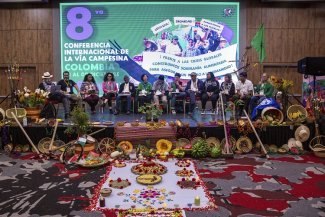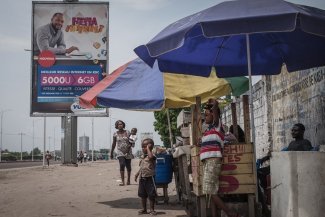Behind China’s friendly narrative, in which it presents of itself as an example to follow for its successful economic transition from communism and for its speedy recovery from the 2008 financial crisis, often lies veiled criticism of the West and the values of liberal democracies.
Located in the Patagonian province of Neuquén, 1300 kilometres west of Buenos Aires in a remote and semi-desert environment close to the Chilean border, a ground station for China’s space programme stands as a symbol of Chinese political power outside of its own borders. The base, which extends over 200 hectares, has an antenna 35 metres in diameter for communicating with objects in deep space. Although officially part of China’s moon programme, and thus intended for scientific use, Western analysts speculate that the Chinese regime could also use it for military purposes.
These are not conspiracy theories. The technology of these antennas is dual use by definition, and the base in Argentina is not staffed by civilians but by four-dozen exclusively Chinese military personnel. By contrast, the European Space Agency’s station in Malargüe, 500 kilometres from the Chinese base, is run by seven Argentinian engineers. Beijing is also clearly motivated by expansion, its facility is the first of its kind in the southern hemisphere. This is no small matter as China is within reach of making up for its deficit in terrestrial infrastructure of this nature, which is key to 24-hour observation and surveillance missions and to its electronic intelligence capacities in the southern hemisphere, including over the Pacific, which, according to experts, could lead to a potential war scenario with the United States.
The agreement for this concession from the Argentinian government was reached in 2015 during the government of Cristina Fernández de Kirchner, when Argentina was completely shut out of global financial markets. China presented itself as an alternative, granting loans and announcing investments and turnkey infrastructure projects including two nuclear power plants.
As part of the same deal, despite accusations of a lack of transparency by Argentina’s political opposition, a last-minute concession was granted, seemingly minor from an economic perspective but of enormous geopolitical significance.
The case perfectly illustrates China’s ability to achieve its political objectives abroad using its economic power as leverage. During the years of the Kirchner government, which was in open confrontation with the Western world, China granted Argentina the status of “comprehensive strategic partner of China,” a status enjoyed by only five countries in all of Latin America.
As part of this partnership, China announced millions in investment, loans and infrastructure spending in an ambitious soft power agenda that allowed the communist regime to penetrate the political, media, cultural and academic spheres of Argentina.
Understanding China’s ‘soft power’ (or ‘sharp power’)
This strategy has been employed in several other Latin American countries in addition to Argentina, as well as in other regions of the world, from Africa to south-east Asia and Australia. So, what is this strategy and why is it so significant?
First, let’s examine the concept of ‘soft power’. The term was coined by American political scientist Joseph Nye to describe the aspect of a country’s power that is based on attraction and arises from a positive perception of its culture, political ideals and public policies. In the case of China’s international strategy, which is primarily based on the ‘bandwagon effect’ of its economic power, there are of course elements of soft power, such as its history and culture. But, inevitably, it is also imbued with the authoritarian values of the Chinese Communist Party (CCP). This is why some analysts have taken to using the concept of ‘sharp power’, which better describes China’s agenda of persuasion abroad.
This is how it works. Beijing essentially uses its chequebook to target all of the individuals and institutions that have influence in the respective countries where it implements its strategy. These include, on the one hand, institutions such as universities, think tanks, media outlets, political parties, and regional and national legislative seats and, on the other hand, local elites such as journalists, opinion leaders, academics, sinologists, active politicians, former diplomats, deputies, high-level officials, activists and young entrepreneurs.
China’s money has enabled it, for example, to open 548 branches and 1193 classrooms of the Confucius Institute throughout the world, in addition to promoting all types of programmes to academic institutions, from teacher exchanges to joint research projects. This alone does not set it apart from other countries with similar cultural programmes such as Germany’s Goethe-Institut, the Alliance française, Spain’s Instituto Cervantes and the British Council. But while the activities, content and scholarships of these respective institutions are open, plural and transparent, Chinese soft power is designed to spread the vision of the CCP.
The Asian giant’s enormous financial resources also allow it to offer foreign audio-visual and print media joint or free production of content on China, a very effective tool at a time when traditional media is facing a crisis, particularly in the developing world.
International correspondents from the regime’s major media outlets, led by China Global Television Network (CGTN) and the Xinhua news agency, are deployed and political agreements are made that authorise the CGTN’s feed to be broadcast in targeted countries. This facilitates the reciprocal broadcast of televised content or the co-production of documentaries. The importance of China’s cooperation with local media was on display at a summit held in a Santiago de Chile, which was attended by 80 representatives of Latin American media and entirely financed by Beijing.
At the summit, Chinese president Xi Jinping announced a commitment to training 500 Latin American journalists in China by 2021, part of a larger programme that aims to train 10,000 Latin Americans that year. Around the same time, President Jinping also announced 10,000 scholarships and 10,000 training opportunities for people from the Arab world. It is important to note, however, that while ‘training’ and ‘certification’ in other contexts would imply ensuring that the beneficiaries of such programmes attain a certain level of competence, Beijing’s so-called ‘people-to-people diplomacy’ is nothing more than a public relations programme including trips to China that always have a pro-government and CCP agenda.
Journalists, politicians, academics and other personalities take part in these expense-paid, weeks-long trips intended to expose these influential elites to Beijing’s propaganda. Upon returning to their countries, they spread the “knowledge” they have acquired on the reality of China to local audiences through journalistic forums, conferences and academic research. Sometimes their support goes even further. In late 2017, the CCP invited representatives of 300 political parties in 120 countries to a four-day summit in Beijing. At the end of the summit, Beijing’s political allies signed a document praising Xi Jinping for his contribution to world peace, providing China with ammunition to counter those who view its growing international influence with reservation. “We highly praise the great effort and major contributions made by the Chinese Communist Party with General Secretary Xi Jinping as its core leader to build a community of shared future for mankind and a peaceful and fine world,” the statement said.
With its formula of making agreements on international cooperation and, at the same time, winning over local elites, the Chinese regime successfully controls the narrative about China that is spread in countries where it invests and has interests.
It is a narrative with two messages. One is explicit, presenting China in a positive light, as a source of development and economic opportunity that is “mutually beneficial” and creates “win-win” synergies. This communist rhetoric portrays China, against a backdrop of international economic uncertainty, as indispensable to the future of the developing world thanks to its investments, loans and infrastructure projects.
The so-called Belt and Road Initiative (BRI), for example, has become an omnipresent foil for all Chinese foreign policy discourse. “Even though Beijing presents the initiative as designed to enhance economic prosperity via the creation of physical linkages across the globe, its real purpose is not infrastructure-building but the creation of a new world order in which China thrives and rules,” says Nadège Rolland, researcher at the National Bureau of Asian Research. As she puts it in her report Mapping the footprint of Belt and Road influence operations: “The perception gap between what BRI is in reality and what Beijing claims it is is the result of a deliberate Party-State worldwide influence campaign waged since BRI’s inception.”
The second message is implicit. Behind China’s friendly narrative, in which it presents of itself as an example to follow for its successful economic transition from communism and for its speedy recovery from the 2008 financial crisis, often lies veiled criticism of the West and the values of liberal democracies. This message emphasises the absence of historical territorial disputes between China and its new partners and often incorporates references to Western colonialism and interventionism, a discourse that is welcomed by certain elites in the developing world.
For many of these elites, China is not only a major trading partner that does not make its aid contingent upon transparency, economic reforms or political factors such as human rights, but also evidence that development is possible without democracy.
Many of them view China’s mixture of political authoritarianism and economic effectiveness with sympathy. This is set against the backdrop of the West’s declining moral authority in the eyes of the rest of the world following the devastating effects of the 2008 financial crisis. The perception that Western democracies have been unable to respond to the challenges of the 21st century has made the Chinese model appear as an attractive alternative.
Objectives of Beijing and the Party: controlling its image, legitimising its worldview
With its financial resources, its strategy of soft power, its successful recruitment of elites with its friendly rhetoric, Beijing aims to achieve several objectives. One is improving its international image. It thus seeks to neutralise its Western critics and change negative perceptions held in certain places, perceptions that the Chinese government claims are spread by Western media and which distort, manipulate and misrepresent reality. Another is internationally legitimising and spreading the worldview of the CCP. In so doing, it fights democratic systems from an ideological perspective and questions global norms and Western values.
The negative consequences of China’s ‘sharp power’ for the young democracies of the developing world should not be overlooked. The news media is one area where the harmful effects of authoritarianism are most visible.
In Peru, where China is the leading foreign investor in the mining sector, local media is very unlikely to report on the social conflicts and violence that periodically erupt over some of the most controversial Chinese projects because of their environmental impact or the precarious working conditions suffered by employees. In Argentina, this strategy helped to turn around an unfavourable situation by neutralising criticism from the influential Argentinian daily newspaper La Nación, which began in response to the lacking transparency in the agreements Cristina Kirchner made with China (including the station in Neuquén),
China played the long game. First, after certain arrangements were made by the Chinese ambassador, La Nación and the Chinese People’s Daily made public an agreement to “jointly distribute content and news.” Two Argentinian executives were then invited to the “One Belt One Road Media Collaboration Forum,” another example of interpersonal diplomacy. The Chinese embassy in Buenos Aires produced and paid for a 16-page supplement in the newspaper on the anniversary of the founding of the People’s Republic of China. This gave the Chinese ambassador the opportunity to spread his message on different occasions from different opinion pages. And, some time later, in a combined effort, certain Chinese companies with interests in Argentina paid for advertising campaigns in La Nación.
On the other hand, in Africa as in Peru, journalists who decide to investigate excesses in Chinese investment and development projects face insurmountable obstacles. These include access to Chinese communities or to Chinese immigrants working on such projects, which is virtually impossible without knowledge of Mandarin. Officials at Chinese embassies or Chinese companies often do not respond to requests for information, a consequence of the fact that transparency and accountability are not the nature of their authoritarian system. When journalists do receive data, it is often difficult to verify. The result is that many excesses that would otherwise be covered by journalists are never brought to light. The above cases highlight a fundamental global risk: Beijing is well positioned to play its cards in order to receive friendly treatment and even neutralise criticism in foreign news media.
Given the challenges faced by many news outlets, including those with a well-earned journalistic reputation, their editorial independence is at risk of being compromised by China’s ‘sharp power’ in the media, thus shaking one of the pillars of democratic systems. The Chinese regime has the ability to engage personally with journalists and editors of foreign media outlets through its ‘people-to-people diplomacy’, which often includes promising economic ‘cooperation’ agreements with Chinese media. Another key factor is the enormous lack of knowledge about China in the rest of the world – a central asymmetry that plays in the Asian giant’s favour.
With so much ignorance and lacking resources, Beijing’s ‘people-to-people diplomacy’ is proving irresistible. The scholarships, exchange programmes, trainings and trips to China paid for by the communist regime have their promoters’ desired effects. Such trips include visits to places of cultural interest, to Chinese infrastructure projects, to companies like Alibaba and Huawei, to provincial legislative seats, to state media, to the regime’s think tanks and to the headquarters of the CCP, among others, where they are received by high-level officials who offer their vision of China’s system of governance, foreign policy priorities and view of the world.
For the journalists, academics, researchers and legislators from so many of the world’s developing countries, where China has a significant economic presence, there are very few opportunities to visit or study China professionally outside of the exchange programmes, training programmes, official trips and courses at the Confucius Institute, all entirely funded by the Chinese government. At the same time, those who have been able to find alternative means of studying in China and thus have prior knowledge of the country, its history, its political system, its culture and its language, cannot be openly critical of the Chinese regime without risking future access to the country and its sources.
Beijing devotes enormous resources to the task of monopolising the narrative on China abroad, not only those of the State and the CCP themselves, but also those of many Chinese entities that help to implement the government’s strategy. These includes friendship associations, universities, think tanks and research institutions, the Confucius Institute, foreign exchange associations, media, student associations and many others that give their foreign partners the impression of being part of civil society and peripheral to the structure of the party-state. However, these actors, which are often the first to initiate contact with foreign elites, are not independent of the state. They unequivocally serve the objectives of the CCP and the nation, either by following official or unofficial guidelines, or by avoiding taking positions contrary to the regime’s objectives.
The Chinese diaspora abroad, which Beijing considers to be an asset, also play a role in this strategy. In order to keep overseas ethnic Chinese communities aligned with the CCP, the strategy known as qiaowu serves to direct them in order to, according to academic James Jiann Hui To, “legitimize and protect the CCP’s hold on power, uphold China’s international image, and retain influence over important channels of access to social, economic and political resources” in the countries where they live. While this may appear as an attempt to encourage cultural interest, increase ethnic consciousness and promote business opportunities, it is designed to legitimise the CCP and elevate China’s image internationally.
In countries which have a tradition of Chinese migration, the Chinese communities targeted by Beijing are often the first points of contact with certain actors in the receiving society. These authentic ambassadors of China, along with the local elites seduced by the CCP, are expected to spread the official narrative of the regime in Beijing – a narrative which projects the values of its authoritarian system and, little by little, is infiltrating and eroding the democratic world.










